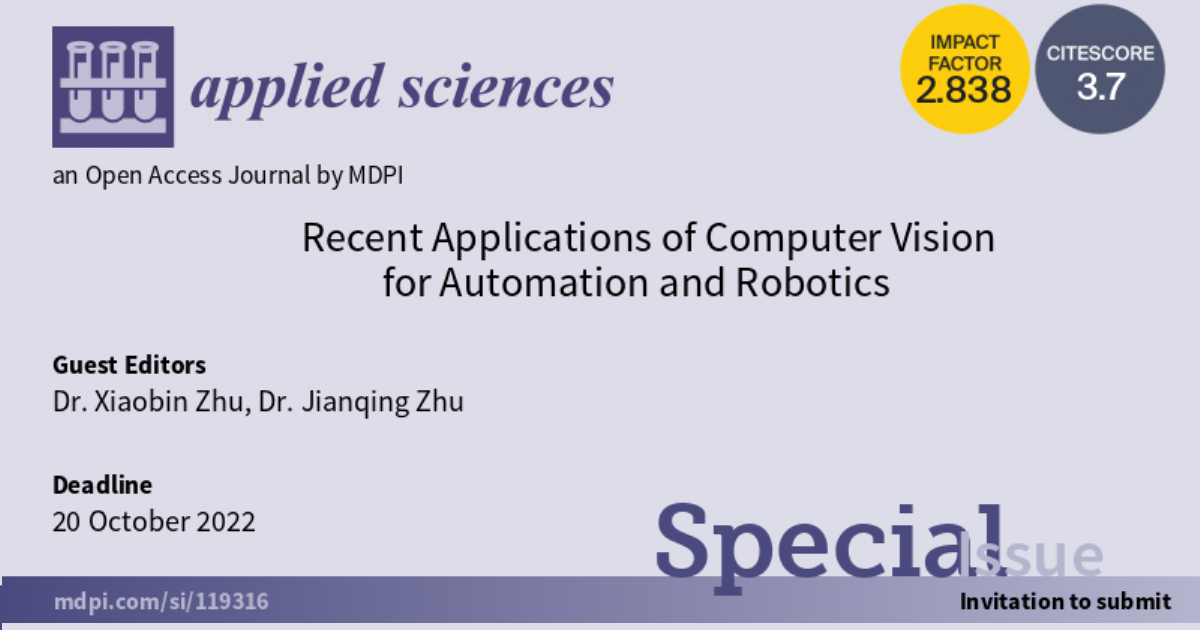Recent Applications of Computer Vision for Automation and Robotics
A special issue of Applied Sciences (ISSN 2076-3417). This special issue belongs to the section "Robotics and Automation".
Deadline for manuscript submissions: closed (20 October 2022) | Viewed by 4295

Special Issue Editors
Interests: image and video processing; pattern recognition; computer vision
Special Issues, Collections and Topics in MDPI journals
Special Issue Information
Dear Colleagues,
We are pleased to invite you to submit your work to our journal. Computer vision applications for automation and robotics have become one of the most rapidly developing areas. Automation and robotics are among the leading areas of practical applications for recently developed artificial intelligence solutions, particularly computer and machine vision algorithms. It opens new challenges and difficulties related to its availability, stability, safety, and computational complexities. This Special Issue tries to highlight the latest research achievements on computer vision applications for automation and robotics to solve these arising challenges. This Special Issue aims to publicize new ideas, original trend analyses, originally developed software, new methods, and other research results concerning computer vision applications for automation and robotics. This Special Issue aims to bring together the research communities interested in computer and machine vision, focusing on both automation and robotics, as well as computer science.
This Special Issue aims to discuss and solve the current key issues and problems related to recent applications of computer vision for automation and robotics. We only accept submissions for articles related to applications of computer vision for automation and robotics.
In this Special Issue, original research articles and reviews are welcome. Research areas may include (but not be limited to) the following:
- Video simultaneous localization and mapping (VSLAM) solutions;
- Image-based navigation of unmanned aerial vehicles (UAVs) and other mobile robots;
- Texture analysis and shape recognition;
- Novel image descriptors useful for image-based classification of objects;
- Feature extraction and image registration;
- Binarization algorithms and binary image analysis;
- Fast algorithms useful for embedded solutions;
- No-reference image quality assessment;
- Natural image analysis;
- Applications of computer vision in autonomous vehicles;
- Image and video scene understanding;
- Image and video reconstruction;
- Intelligent transport and logistics;
- Biomedical engineering;
- The safety of the human-machine interactions.
We look forward to receiving your contributions.
Dr. Xiaobin Zhu
Dr. Jianqing Zhu
Guest Editors
Manuscript Submission Information
Manuscripts should be submitted online at www.mdpi.com by registering and logging in to this website. Once you are registered, click here to go to the submission form. Manuscripts can be submitted until the deadline. All submissions that pass pre-check are peer-reviewed. Accepted papers will be published continuously in the journal (as soon as accepted) and will be listed together on the special issue website. Research articles, review articles as well as short communications are invited. For planned papers, a title and short abstract (about 100 words) can be sent to the Editorial Office for announcement on this website.
Submitted manuscripts should not have been published previously, nor be under consideration for publication elsewhere (except conference proceedings papers). All manuscripts are thoroughly refereed through a single-blind peer-review process. A guide for authors and other relevant information for submission of manuscripts is available on the Instructions for Authors page. Applied Sciences is an international peer-reviewed open access semimonthly journal published by MDPI.
Please visit the Instructions for Authors page before submitting a manuscript. The Article Processing Charge (APC) for publication in this open access journal is 2400 CHF (Swiss Francs). Submitted papers should be well formatted and use good English. Authors may use MDPI's English editing service prior to publication or during author revisions.
Keywords
- automation and robotics
- computer vision applications
- image analysis
- video analysis






